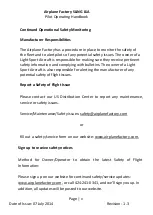
Airplane Factory SLING LSA
Pilot Operating Handbook
Page | 1-3
Date of Issue: 07 July 2014
Revision : 1.3
1.1
Introduction to airplane
The Airplane Factory Sling LSA is a two seat (side-by-side), single engine,
tricycle undercarriage aluminum aircraft with a conventional low wing design
and is compliant with the requirements of the FAA Light Sport Aircraft (LSA)
category according to ASTM Standards F2245, F2279 and F2295.
With only minor modifications to the aircraft and the application of a revised
Pilot’s Operating Handbook the Sling LSA may be made to comply with the
requirements of the EASA (European Aviation Safety Agency) CS-VLA
(Certification Standard Very Light Aircraft) standard, having a maximum all up
weight of 700 kg (1543.24 lb).
The Sling LSA is intended chiefly for recreational and cross-country flying. It is
not intended for aerobatic operation. It is considered to be suitable for use as
a trainer. This Pilot Operating Handbook has been prepared to provide pilots
with information for the safe and efficient operation of the Sling LSA.










































